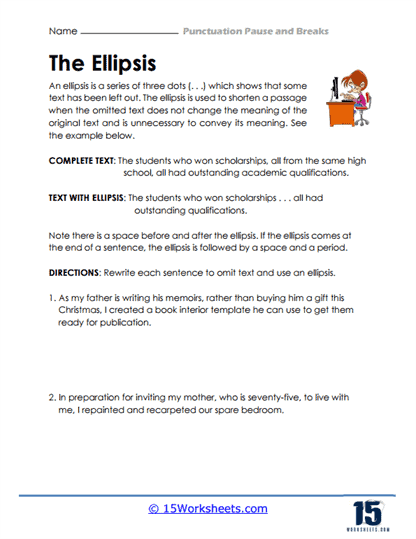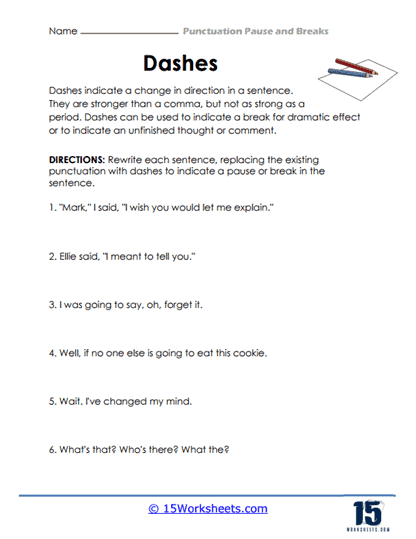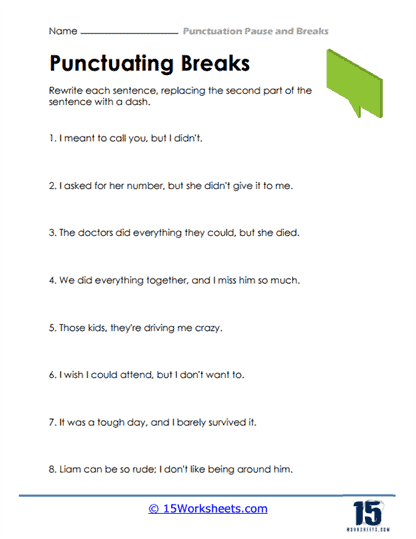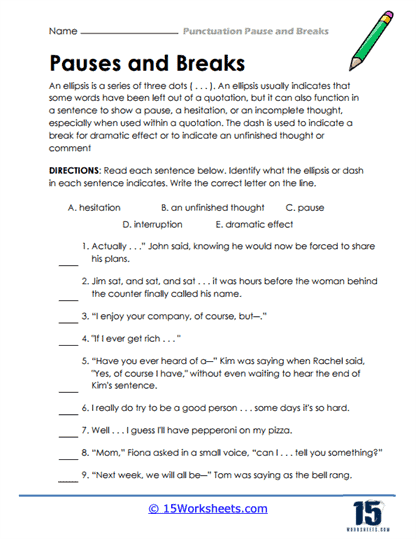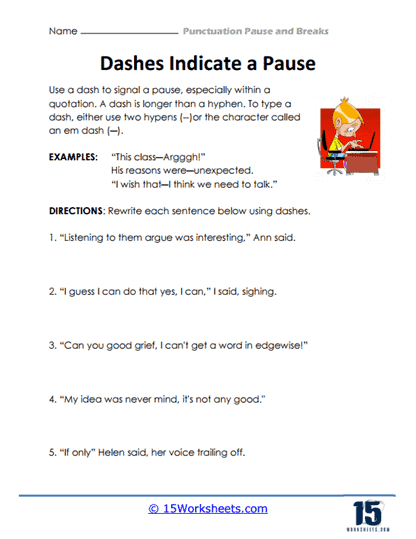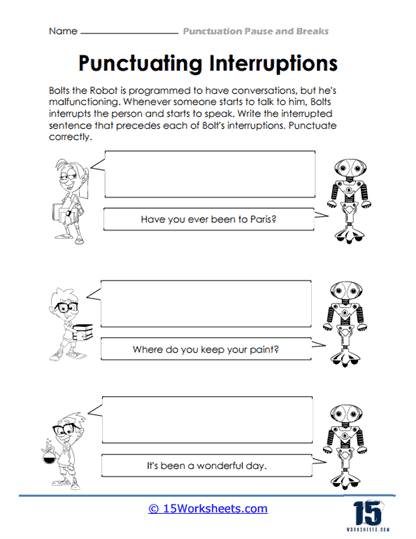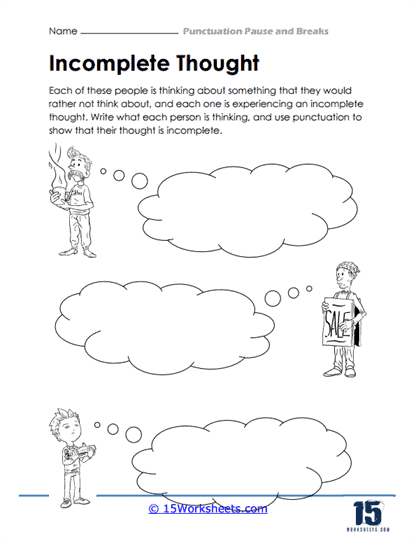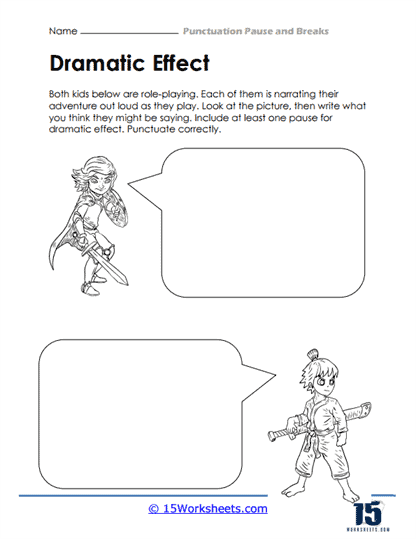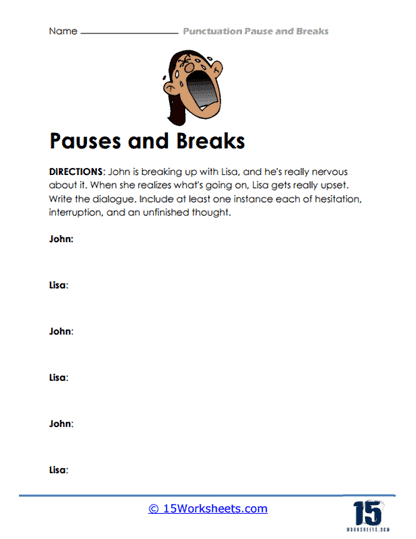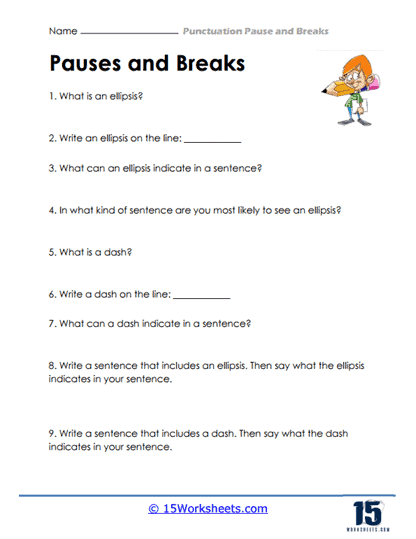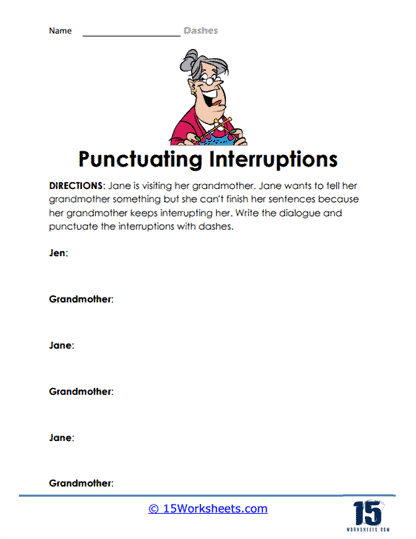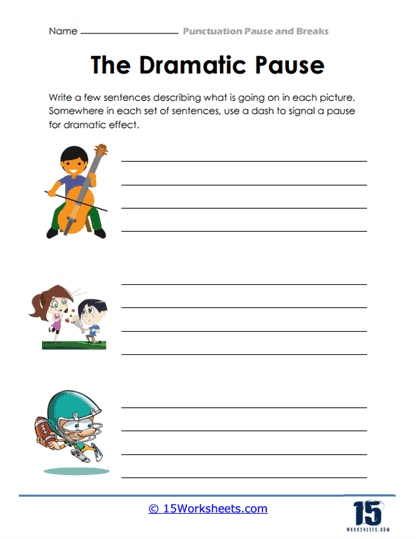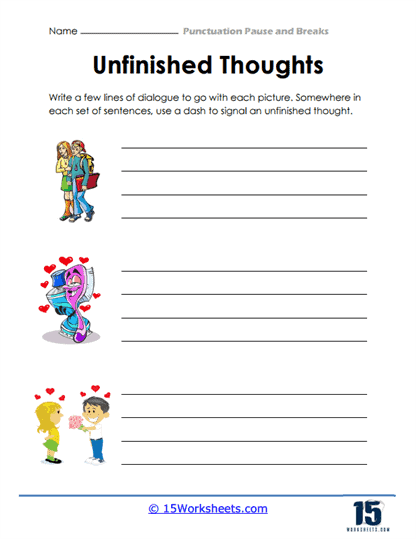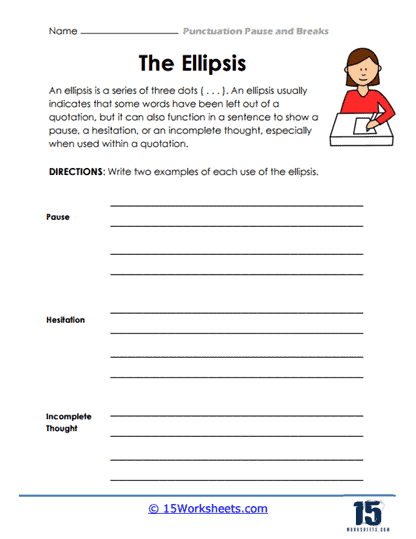Pauses Worksheets
All About These 15 Worksheets
These worksheets will have students learn how to correct the use of pauses in written and spoken language. These pauses are usually represented by punctuation marks in written language such as commas, periods, colons, semicolons, and dashes.
Here’s an example of what an exercise in a Pauses Worksheet might look like:
Add the correct punctuation mark to indicate a pause in the following sentences:
a) I need to buy eggs milk and bread from the grocery store.
b) She was tired yet she continued to study for her exam.
c) He was a tall friendly man.
In this exercise, students might add commas to sentence (a) (“I need to buy eggs, milk, and bread from the grocery store.”), a semicolon or comma to sentence (b) (“She was tired, yet she continued to study for her exam.”), and commas to sentence (c) (“He was a tall, friendly man.”).
For spoken language, a Pauses Worksheet might have audio clips where students need to identify where the speaker pauses, how long the pause is, and what effect this has on the meaning or tone of what’s being said.
Remember, the use of pauses can vary widely between different types of writing and speaking, and different style guides might have different rules. These worksheets aim to give students a general understanding that they can then apply in more specific contexts.
What Punctuation Marks Do We Use to Indicate a Pause or Break
In writing, there are several types of punctuation marks that can be used to indicate a pause or break in a sentence. These punctuation marks help convey the intended rhythm, emphasis, and structure of the written text. Here are some common punctuation marks used for this purpose:
Comma (,) – A comma is a versatile punctuation mark used to indicate a brief pause within a sentence. It can be used to separate items in a list, separate clauses in a compound sentence, or provide a pause between phrases.
Example: She went to the store, picked up some groceries, and headed back home.
Semicolon (;) – A semicolon is used to indicate a slightly longer pause than a comma. It is often used to separate two closely related independent clauses or to separate items in a list when the items themselves contain commas.
Example: She finished her work; now she could relax and enjoy her weekend.
Colon (:) – A colon is used to introduce a list, explanation, or a quotation. It can also indicate a pause before presenting additional information.
Example: There are three colors that make up the national flag: red, white, and blue.
Dash (- or -) – Dashes can be used to indicate a more significant break or interruption in a sentence. They can replace other punctuation marks like commas or parentheses for emphasis or to set off additional information.
Example: The recipe called for three main ingredients-flour, sugar, and eggs-but she decided to add a few extras.
Parentheses ( ) – Parentheses are used to set off additional information or an aside within a sentence. They indicate a break in the flow of the main text.
Example: The concert (which was sold out) was a tremendous success.
Ellipsis (…) – An ellipsis is a set of three dots (…) used to indicate an intentional omission of words, a pause, or a trailing-off thought.
Example: I thought we were going to… Oh, never mind.
Why Do Authors Use Pauses In Literature?
Authors use pauses in literature for several reasons, as pauses can serve various functions in the writing. Here are some common reasons why authors use pauses:
Rhythm and Pace – Pauses help control the rhythm and pace of the writing. By strategically placing pauses, authors can create a certain flow and tempo in their prose. Short pauses, such as commas, can quicken the pace, while longer pauses, like dashes or ellipses, can slow it down, adding suspense or a sense of contemplation.
Emphasis and Clarity – Pauses can be used to emphasize specific words, phrases, or ideas. By inserting pauses, authors can draw attention to key elements of their writing and make them stand out. Pauses also help to clarify the meaning of a sentence or to indicate a shift in thought.
Dramatic Effect – Pauses can create dramatic effect and tension in a narrative. They can build suspense, heighten anticipation, or create a moment of silence that intensifies the impact of an event or revelation. Well-placed pauses can enhance the emotional impact of a scene or dialogue.
Deliberation and Thoughtfulness – Pauses can convey a sense of thoughtfulness, reflection, or hesitation. They allow characters to pause and consider their words or actions, adding depth to their portrayal. Pauses can also indicate a character’s internal monologue or the passage of time as they gather their thoughts.
Stylistic Choices – Different authors have unique writing styles and preferences. Some authors may naturally incorporate pauses in their writing to reflect their voice or personal style. Pauses can contribute to the overall tone and atmosphere of a literary work, adding a distinctive flavor to the prose.
Dialogues and Speech Patterns – Pauses are often used in dialogues to mimic natural speech patterns. People naturally pause while speaking, whether for emphasis, to gather their thoughts, or to allow others to interject. By including pauses in dialogues, authors can make the conversations feel more authentic and realistic.

